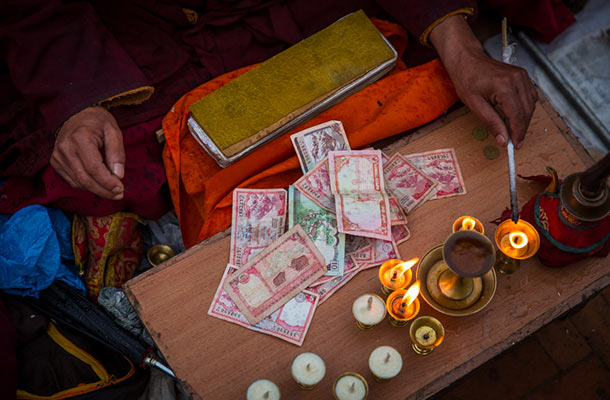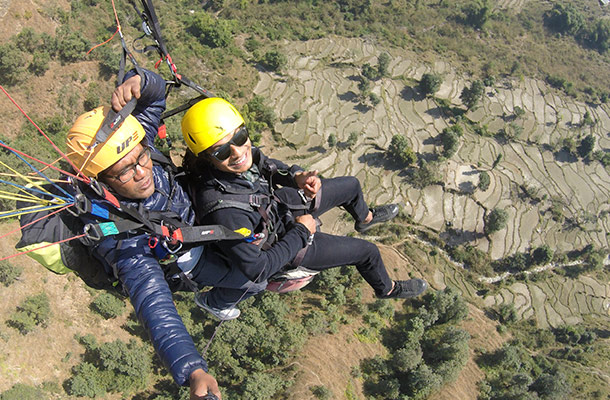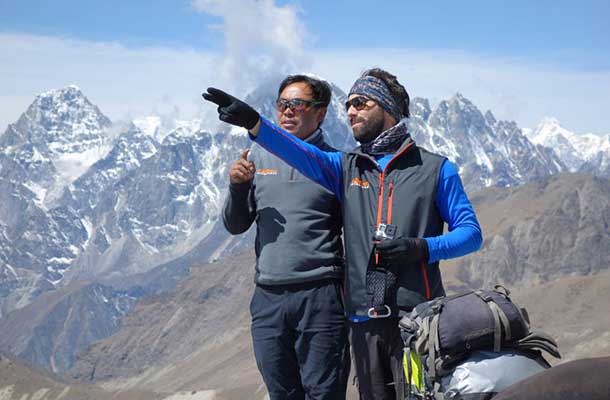Money Tips for Nepal: An Essential Cost Guide
Planning a trip to Nepal? Find out how to save money and experience adventure in the Himalayas with these money tips for travelers from our local insider, Maria.
 Photo © Mahadev Rojas Toras
Photo © Mahadev Rojas Toras
- Average prices overall in Nepal
- Average food and drink prices in Nepal
- Beer prices in Nepal
- Packet food and snack prices in Nepal
- Accommodation prices in Nepal
- Trekking service prices in Nepal
- Bargaining in Nepal
Average prices overall in Nepal
Between 2005 and 2011, USD $1 would buy 60 Nepalese Rupees. In 2013, you’d get 87 – 90 Rupees, and in 2016 it has jumped to 106 Nepalese Rupees.
Prices for goods in Nepal jumped as well. For example, in 2005 a traveler would pay USD $10 for a porters’ services, while in 2016 you’ll pay closer to USD $20.
One unusual universal indicator of the prices in Nepal is the price for dal bhat - a traditional Nepali dish.
- Kathmandu’s local cafés will charge 100-150 Rupees for dal bhat
- At an elevation of 4,500m a vegetarian can expect to pay 750 Rupees, and non-vegetarians will pay 200 – 850 Rupees for the traditional meal.
Generally, you’ll notice a consistent pattern: the higher you are, the more expensive your meals will cost.
Average food and drink prices in Nepal
To save those pennies, your cheapest option for food in Nepal is to eat at local cafes and teahouses.
Average food prices in the valley regions of Nepal
In Kathmandu and Pokhara, expect to pay:
- Drinks, such as a cup of tea: 10-30 Rupees per cup
- Chapati (flat bread): 10-30 per piece
- Momo (Nepali dumplings): 50-100
- Fried eggs: 30 – 50
- Samosa (Nepali pastry with spicy filling and fried in oil): 10-30 per piece
If you go to a tourist restaurant, expect to pay three to four times more. The cafes and restaurants for tourists serve a variety of meals, and your average meal with a non-alcoholic beverage may cost 7-20 USD.
Average food prices in the mountains and National Parks of Nepal
Mountain lodges have fixed menus, and the regional committees or administrative bodies of national parks set the prices, so bargaining will not work here.
If you want to buy a potato or pasta dish, rice with vegetables, or momo at the elevation of 4,500m, it will cost as much as 400-700 rupees, with the exception of dal bhat, which will cost up to 900 Rupees.
Due to the influence of western culture and a market demand, new services are rapidly popping up all over Nepal.
For example, bakeries, pizzerias and cheese shops exist now, even at the elevation of 3,500-4,000m. So, if you’re craving a cinnamon roll, chocolate cake, or a cup of freshly brewed coffee, be prepared to pay 300-500 Rupees.
Beer prices in Nepal
There are a couple of local beers in Nepal, and a 600ml bottle will cost you 250 – 700 Rupees, depending on the elevation.
Packet food and snack prices in Nepal
Western-style snacks, sweets, and chocolates are obviously more expensive in Nepal than locally-grown and cooked foods.
A 200g pack of cookies will cost 30-50 Rupees in Kathmandu, and up to 200 Rupees in the mountains.
Accommodation prices in Nepal
In the major cities of Nepal, you can find hotels and guesthouses to suit any budget.
A basic bed in a dorm room will cost 200 Rupees (USD $2), or if you’re looking to stay one night in a luxury hotel, you’ll pay up to 13,000 Rupees (USD $120).
The cost of the accommodation in the trekking lodges varies. In some regions, you can get a room for free if you pay to eat where you stay.
In Langtang-Helambu National Park, which suffered from the earthquake in 2015, we paid close to 1,000 Rupees for a very basic room with 5 people in the Spring of 2016.
Trekking service prices in Nepal
The cost of the trekking permits are the same for everyone – they’re not negotiable and will vary from 2,000 Rupees (USD $20) up to 34,000 Rupees (USD $500), depending on the region.
The cost of the porter’s work is USD $15-25 per day, where the guides charge normally USD $30-40 a day.
When hiring a porter or a guide through an agency, make sure the cost of food and medical insurance for your Nepali staff are included into the price.
Bargaining in Nepal
Although many travelers don’t have a habit of bargaining back home, it’s part of the culture throughout much of Asia – especially in Nepal.
So, don’t hesitate to bargain and negotiate prices down in markets, but never where there is a set menu or recommended price in store.
Related articles
Simple and flexible travel insurance
You can buy at home or while traveling, and claim online from anywhere in the world. With 150+ adventure activities covered and 24/7 emergency assistance.
Get a quote

No Comments